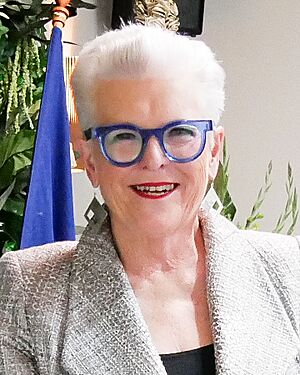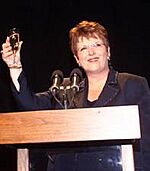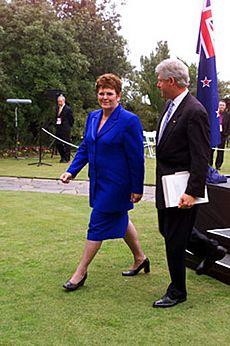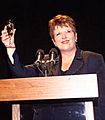Jenny Shipley facts for kids
Quick facts for kids
Dame Jenny Shipley
|
|
|---|---|

Shipley in 2020
|
|
| 36th Prime Minister of New Zealand | |
| In office 8 December 1997 – 10 December 1999 |
|
| Monarch | Elizabeth II |
| Governor-General | Michael Hardie Boys |
| Deputy | Winston Peters Wyatt Creech |
| Preceded by | Jim Bolger |
| Succeeded by | Helen Clark |
| 28th Leader of the Opposition | |
| In office 10 December 1999 – 8 October 2001 |
|
| Prime Minister | Helen Clark |
| Deputy | Wyatt Creech Bill English |
| Preceded by | Helen Clark |
| Succeeded by | Bill English |
| 8th Minister for State Owned Enterprises | |
| In office 16 December 1996 – 8 December 1997 |
|
| Prime Minister | Jim Bolger |
| Preceded by | Philip Burdon |
| Succeeded by | Tony Ryall |
| 32nd Minister of Health | |
| In office 29 November 1993 – 16 December 1996 |
|
| Prime Minister | Jim Bolger |
| Preceded by | Bill Birch |
| Succeeded by | Bill English |
| 19th Minister for Social Welfare | |
| In office 2 November 1990 – 29 November 1993 |
|
| Prime Minister | Jim Bolger |
| Preceded by | Michael Cullen |
| Succeeded by | Peter Gresham |
| Member of the New Zealand Parliament for Rakaia Ashburton (1987–1990) |
|
| In office 15 August 1987 – 27 July 2002 |
|
| Preceded by | Rob Talbot |
| Succeeded by | Brian Connell |
| Personal details | |
| Born |
Jennifer Mary Robson
4 February 1952 Gore, New Zealand |
| Political party | National |
| Spouse |
Burton Shipley
(m. 1972) |
| Children | 2 |
Dame Jenny Shipley (born 4 February 1952) is a New Zealand politician who made history. She was the 36th Prime Minister of New Zealand from 1997 to 1999. Dame Jenny was the first woman to become Prime Minister of New Zealand. She was also the first woman to lead the National Party.
Jenny Shipley was born in Gore, Southland. She grew up in rural Canterbury. Before becoming a politician, she worked as a schoolteacher. She was also involved in many community groups.
Contents
Early Life and Education
Jenny Shipley's birth name was Jennifer Mary Robson. She was born in Gore, New Zealand, and was one of four sisters. Her father, Rev. Leonard Cameron Robson, was a Presbyterian minister.
After attending Marlborough Girls' College, she trained as a teacher. She qualified in 1971 from the Christchurch College of Education. She taught in primary schools in New Zealand until 1976. In 1973, she married Burton Shipley and they settled in Ashburton.
Becoming a Member of Parliament
| New Zealand Parliament | ||||
| Years | Term | Electorate | List | Party |
| 1987–1990 | 42nd | Ashburton | National | |
| 1990–1993 | 43rd | Ashburton | National | |
| 1993–1996 | 44th | Rakaia | National | |
| 1996–1999 | 45th | Rakaia | 4 | National |
| 1999–2002 | 46th | Rakaia | 1 | National
|
Jenny Shipley joined the National Party in 1975. She was elected to Parliament in the 1987 election. She won the Ashburton area, which was a strong National Party area. When she entered Parliament at age 35, she was one of the youngest members.
Serving as a Cabinet Minister
Shipley quickly became important within the National Party. In 1990, the party leader, Jim Bolger, made her the party's spokesperson for social welfare. When the National Party won the 1990 election, Shipley was re-elected. Her area was renamed Rakaia.
She became the Minister of Social Welfare. She also served as Minister for Women's Affairs from 1990 to 1996. In these roles, she oversaw changes to government benefits.
Later, in 1993, she became Minister of Health. She worked to change the public health service. The National Party won another election in 1996. They formed a coalition government with New Zealand First. Shipley then took on new roles, including Minister for State-Owned Enterprises and Minister of Transport.
In 1993, Shipley received the New Zealand Suffrage Centennial Medal. This medal celebrated 100 years since women gained the right to vote in New Zealand.
Becoming Prime Minister (1997–1999)
 |
|
|
Premiership of Jenny Shipley
|
|
|---|---|
| 8 December 1997 – 10 December 1999 | |
| Elizabeth II | |
| Cabinet | Fourth National Government of New Zealand |
| Party | New Zealand National Party |
| Appointer | Michael Hardie Boys |
| Seat | Premier House |
|
← Jim Bolger • Helen Clark →
|
|
Jenny Shipley felt that the government under Jim Bolger was moving too slowly. She also felt that New Zealand First had too much influence. In mid-1997, she began to gather support to become the new leader.
While Bolger was away at a meeting, Shipley convinced many of her National Party colleagues to support her. When Bolger returned, he saw that Shipley had enough support to take over. He resigned, and Shipley was chosen as the new leader without opposition. She became Prime Minister on 8 December 1997.
The government became less stable, especially the relationship between the National Party and New Zealand First. On 14 August 1998, Shipley removed Winston Peters, the leader of New Zealand First, from his Cabinet role.
Shipley was sometimes called "the perfumed steamroller." She noted that female politicians were often described differently by the media. For example, male politicians might be called "bold," while women might be called "vindictive."
During her time as Prime Minister, Shipley supported the silver fern on a black background as a possible new flag for New Zealand. This was similar to the Canadian flag.
In September 1999, Auckland hosted the APEC Summit. Shipley met with the President of the United States, Bill Clinton. This was one of only two times a US president has made a state visit to New Zealand.
Shipley was the first Prime Minister to attend the gay and lesbian Hero Parade. She also supported lowering the alcohol purchase age from 20 to 18, which happened in 1999. She wanted to broaden the types of people who supported the National Party.
Shipley became a member of the Council of Women World Leaders. This is a group of current and former women presidents and prime ministers from around the world.
Election Defeat and Leaving Politics
Shipley led the National Party into the 1999 election. She hoped to be the first woman elected Prime Minister in her own right. However, her government was defeated by the Labour Party. This party was led by another woman, Helen Clark. This election was a big moment for New Zealand. It was the first time both major parties were led by women.
Shipley remained the Leader of the Opposition until October 2001. Then, Bill English became the new National Party leader. Shipley left Parliament in January 2002.
In 2003, Shipley was appointed a Distinguished Companion of the New Zealand Order of Merit. This was for her work as a Member of Parliament. In 2009, she accepted the redesignation as a Dame Companion of the New Zealand Order of Merit.
Life After Politics
After leaving politics, Jenny Shipley became involved in business and charity work. In 2007, she joined a financial services company. From 2009 to 2018, she was the chair of the Genesis Energy Limited board. She also served on the board of the New Zealand branch of the China Construction Bank.
Involvement with Mainzeal Company
Jenny Shipley was on the board of directors for a construction company called Mainzeal Property & Construction. In 2013, the company faced financial difficulties and went into a process called receivership. This means that a special person was appointed to manage the company's money because it was having problems. Shipley and other directors resigned from the board. Later, Mainzeal went into liquidation, owing a lot of money.
A lawsuit was filed against the former Mainzeal directors, including Shipley. The court found that the directors had not been careful enough in their trading. The court ordered the directors to pay a total amount, with Shipley's share being a specific amount. This decision was upheld by New Zealand's Supreme Court in August 2023.
Television and Charity Work
In 2009, Shipley appeared on a television travel show called Intrepid Journeys. She visited Namibia during the show. After her trip, she started a charity called the Namibian Educational Trust. This charity helps a school she visited there.
Shipley also chaired Global Women NZ until 2015. She was also the patron for the Sir Edmund Hillary Outdoor Pursuits Centre and supported the New Zealand National Heart Foundation's "Go Red for Women" campaign.
Images for kids
See also
 In Spanish: Jenny Shipley para niños
In Spanish: Jenny Shipley para niños




